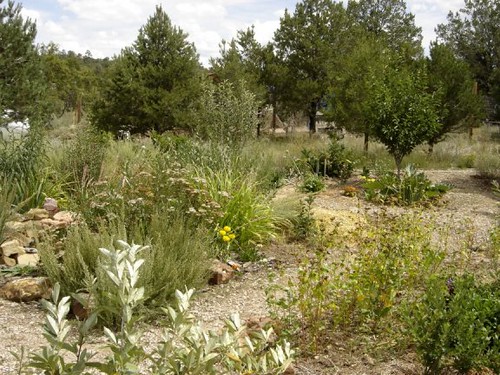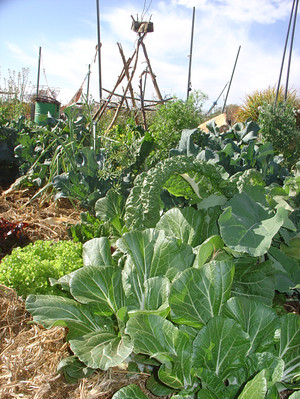Abundance in Drylands

Drylands greywater kitchen garden at Ampersand Sustainable Learning Center, Arizona
In the course of researching for our upcoming Permaculture Design Course in Alice Springs this April, I've come across quite a few great new resources for food security and regeneration for desert environments.
And it would seem to me, as is usually the case, the main blockage between most modern drylands habitats becoming abundant places to inhabit is the time-worn problem of access to appropriate knowledge.
Fortunately, and somewhat mysteriously, our species has a very long history of living in seemingly inhospitable environments the world over. Traditional techniques that served previous generations with food and housing are not always possible in todays world, and so much knowledge has been lost in the last century with the arrival of industrialised (and colonial) everything.
In Australia, our own red centre is a case in point. Despite being the homeland of the oldest continuing civilisation on the planet (yup, really), many of Australia's indigenous nations have been disenfranchised by industrialised food systems which have brought almost complete dependance on the multi-national supermarket for nutrition. I'll leave the cataclysm of other aspects of indigenous disenfranchisement for you to ponder – I'm sure you have some idea of what has, and continues, to be affecting our indigenous nations. If not, start here.

Digging a greywater system at Bustan Qaraaqa, Palestine.
Food security is something we should all be deeply passionate and active about. Really truly. By the way, what will you be eating for your very next meal after you read this article? Have a look on your plate. Know where any of it actually came from, in more than a vague i-hope-it's-from-somewhere-nearby sense? Know for a fact that any of it was produced within a truly sustainable framework?
Hmm. See what i mean? This is bigtime.
Designing resilience and security into our communities, in terms of food, livability and durability, is something we all need to attend to, starting today. But that need is perhaps more starkly apparent in environments where water is exquisitely valuable, any topsoil is not to be sniffed at and perceptions of what 'should grow' may be not very accurate.
Dry and brittle environments hold possibilities for both deep disappointment and joy for Permaculture designers. If you design + implement your system right, you get an amazing, resilient oasis. Get it wrong, and everything dies.
Which is why good design principles are so important. Design from pattern to details. Catch and store energy. Value the edge. Slow, small solutions. Observe and interact. Take these principles any way you want, on a micro or macrocosmic scale. Interpret them in terms of species selection, water harvesting, people care, family dynamics, urban planning, you name it. And if you do get it wrong, go back to the principles and re-design with the benefit of hindsight, observing and interacting as you go.
I think our PDC in Alice is going to be very energising and challenging for everyone involved. Challenging for us in terms of teaching (and learning from) students who deal with a desert biosphere and its associated parameters (environmental and social) every day, and energising for those who attend in terms of what possibilities are out there for designing communities for endurance and abundance.

Greywater oasis at Whoville Gardens, New Mexico
Fortunately, we'll be standing on the shoulders of giants in terms of sharing knowledge and skills for better living in drylands – here's a couple of the stellar resources we'll be working with:
- Introduction to induced meandering: Bill Zeedyk is a legend of drylands regeneration. This introductory article merges good design with first-peoples understanding of hydrology to produce super simple and ardently effective solutions for managing and preventing waterway erosion in drylands and beyond.
- Quivira Coalition: This group is fast emerging in the Americas as a locus for innovative restoration and sustainable agriculture working with larger scale projects. The website seems a bit stuffy, but there's many jewels pointing to further research.
- Water Harvesting For Drylands: a book series by Brad Landcaster that I've mentioned before, but I'm mentioning it again because it kicks butt. Any community or council presented with a decent slideshow of the images in these books would then be ready for a full-blown discussion on how to move forward on this stuff.
- Oasis Design: Art Luwdig's extensive work throughout Latin America on building safe greywater gardens and waste systems can't be overstated in terms of relevance and importance given what's going on around the world right now. Tried and tested techniques. Don't let their simplicity fool you – this is design elegance at its most basic and immediately effective level.
- Jordan family house: A little overview of techniques suggested for better living + gardening in Jordan, one of the lowest and driest places on earth, by the infatigable Lawton family.
- Sink and Wall garden: simple yet effective. A small blog post from the Fantons on the road in India.
From a certain world view, the drylands of this planet represent possibilities for the ultimate in economical living, and the exquisite duality which comes with the idea of the oasis (so deeply embedded in all our cultural memories).
Add to that the extensive and far-reaching indigenous knowledge of country, some of which we will have access to during our time in the Alice, and i think the possibilities are endless for future drylands living which fuses many forms of knowledge together to make truly abundant communities possible – both in Australia, and beyond.

